15 million energy customers on SVTs will see their bills increase by over £100 a year on 1 April
Low income large families, those on benefits and pensioners – particularly in Merseyside, northern Scotland, and south Wales – will be some of the worst hit, facing increases of up to £147
Credit and prepayment meter customers with 36 suppliers have been told their energy prices are rising, adding up to £1.67 billion to the nation’s bill
But wholesale energy costs are now falling back towards 12 month lows and cheaper tariffs are coming back onto the market
Uswitch.com urges consumers to act now – they could save over £300 by switching and avoid price hikes from 1 April.
The clock is ticking on one of the biggest bill shocks this decade. On 1st April £1.67 billion is set to be added to the nation’s energy bill and, according to new analysis from price comparison and switching service Uswitch.com, the hardest hit will be those who can least afford it.
Last month, Ofgem announced that it was increasing the level of the price cap on poor value standard variable tariffs (SVTs) to an average of £1,254 per year. Since then, 36 suppliers have all raised prices by over 10% on average.
As a result, large families in socially-rented houses whose energy supplier prices up to the cap will be paying an average of £127 extra per year. This equates to 5.7% of an assumed annual income of £24,000. But those in the Scottish Hydro energy region in northern Scotland face average increases of up to £147 a year, pushing their annual bill above £1,700 and eating up a punishing 7.3% of their total £23,000 income.
However, households on benefits face an even bleaker cliff edge as more of their income will be swallowed up paying for gas and electricity. Nationwide, the average bill increase for single people or young families on benefits could be £114 (accounting for 6.5% of an assumed £19,000 annual income). Yet in the Swalec energy region in southern Wales, bills for these households could rise by £127 to £1,339 per year – meaning their energy costs would represent a staggering 8.4% of their entire £16,000 budget.
This compares to increases for more affluent energy customers, such as prosperous suburban families, where the biggest bill hike of £203 in London will take prices to an eye watering £1,977 a year yet account for just 2.2% of an £87,000 assumed annual income.
Also struggling to get by in the current economic climate, young families in low cost, privately rented accommodation around the country are likely to see an average increase of £102 per year. But it will be a particularly bitter pill to swallow in parts of Merseyside and north Wales, where the average bill increases could cost an extra £123, leaving those households with a total bill of £1,198 a year – 4.6% of the £26,000 they bring home annually.
And although they saved hard to give themselves a comfortable quality of life after they finished working, pensioners in some parts of the country are now looking at spending almost 5% of their retirement income on gas and electricity from 1 April. Households in northern Scotland are again hardest hit in this demographic group, with standard tariffs increasing by over £130 a year to £1,558.
Rising wholesale costs have driven the increase in the price cap level, but this will be cold comfort to those who were misled by the idea that the cap would protect them from costly hikes. Over 11 million energy customers on standard credit meter tariffs face an average bill hike of £117 a year, while a further 3.6 million customers with prepayment meters could each be in line for an average increase of £106. At a total cost of £1.67bn, this is the largest price increase in a single day since 2011.
Around the country, regional variations in the cost of supplying gas and electricity mean that increases in average bills will differ. From 1 April the difference between the lowest average Big Six standard tariff of £1,221 per year in the East Midlands, and the highest, in south west England (£1,293), will be as much as £72 – driven by the varying cost of maintaining the pipes and wires in different parts of the country. Elsewhere in Britain, Big Six SVTs are going up by 11.6% to £1,291 per year on average in north Wales (ManWeb energy region) and by 9.1% to £1,257 annually in northern Scotland (Scottish Hydro energy region).
Rather than relying on the price cap, if consumers had moved to the cheapest fixed deal on 1 January when the cap came into force, they would only be paying £903 for their energy this year. The best deal on the market today is £892, a whopping £362 lower than the new cap level of £1,254 – which all of the Big Six suppliers are pricing up to from 1 April.
Rik Smith, energy expert at Uswitch.com, says: “These price rises will add more pressure to household budgets across the country, but unfortunately the people that will feel it most are the families who are already struggling to make ends meet.
“This may seem like a cruel April fools joke, but it’s no laughing matter. The stark reality is that the very cap that was supposed to protect customers on poor value standard tariffs is now responsible for some of the harshest price increases in recent memory. Consumers have just days left before their energy bills will skyrocket. Yet this is at a time when it’s getting cheaper for energy suppliers to buy gas and electricity on the open market, and as a result there are now lots more cheap deals below £1000 a year available.
“It is vital that households are not lulled into a false sense of security by the idea of a price cap. You can switch to a much cheaper rate in minutes and save over £300 compared to staying on a standard plan that’s priced right up to the level of the cap. So many other bills and taxes are going to cost more from 1 April, but your gas and electricity needn’t be one of them.”
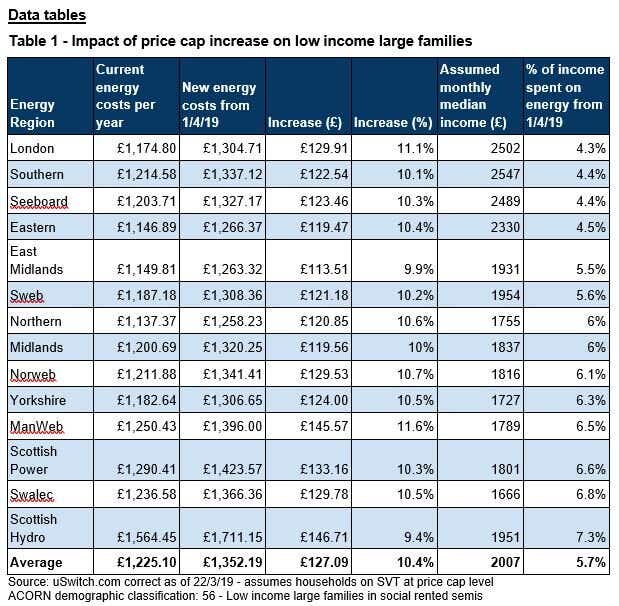
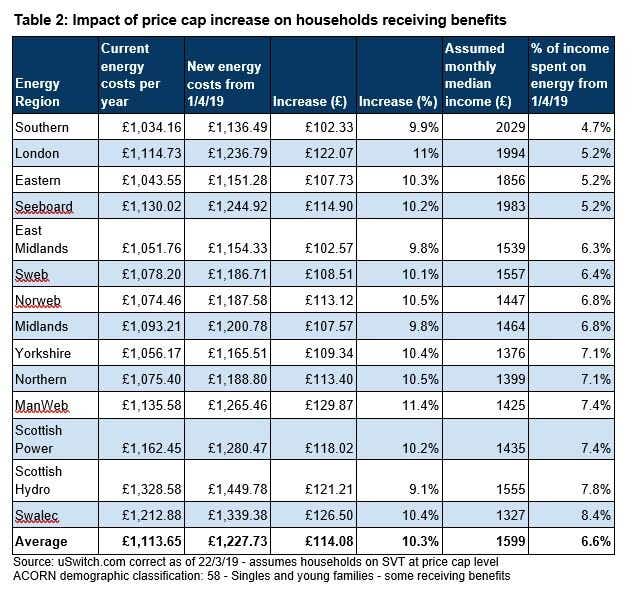
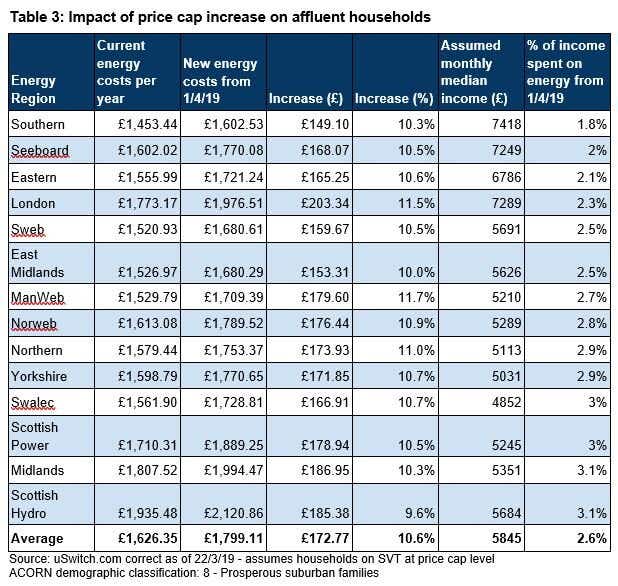
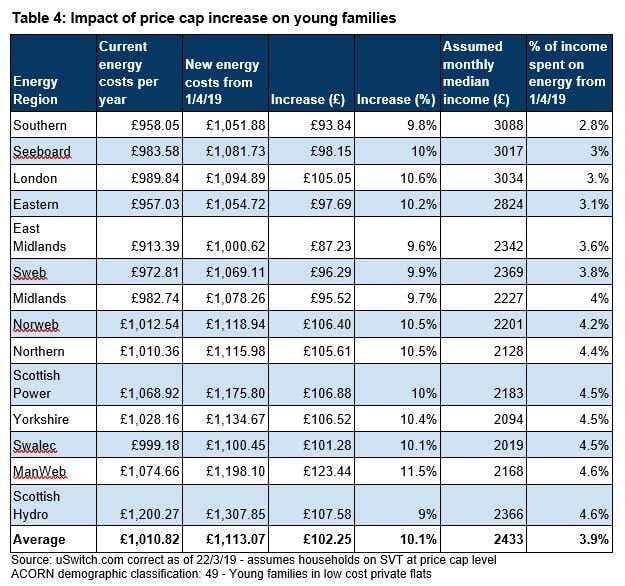
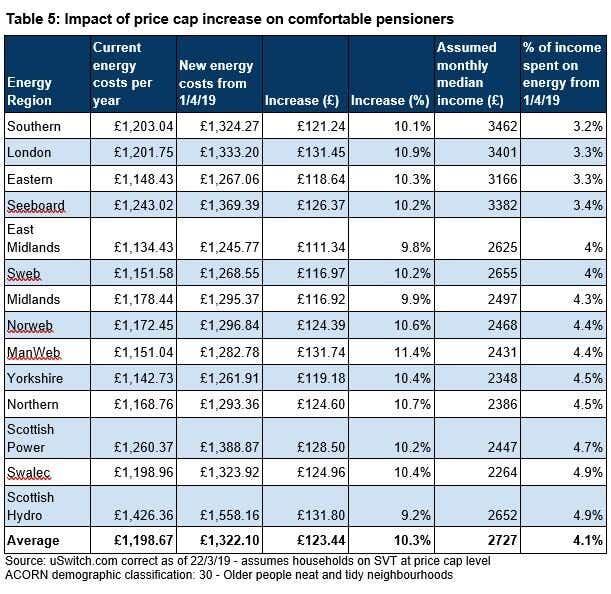

FOR MORE INFORMATION
Tim Dunford
Phone: 020 3872 5612
Mobile: 07785 552666
Email: tim.dunford@uswitch.com
Twitter: @uswitchPR
Notes to editors
Source: Uswitch.com
See Table 1 in the body of the press release. Proportion of assumed annual income spent on energy bill calculated using Uswitch data on the median annual energy usage from actual energy comparisons in that ACORN demographic group. This is cross-referenced against average regional energy prices to calculate the likely bill for a household in a demographic group in a particular energy region. The assumed annual income is calculated by applying regional variations seen in ONS income data to national level Acorn income data showing median household income per demographic group.
Example: Uswitch data for ACORN demographic group 56 suggests from 01/04/2019 these households will spend an average £1,352 per year on energy, across all energy regions. Applied to households in the Scottish Hydro energy region this spend is £1,711. Median annual income for this ACORN demographic group is £22,611 according to ACORN data. Using ONS regional variations this means the median annual income for this demographic in this energy region becomes £23,412. £1,711 as a percentage of £23,412 is 7.31%
Source: Uswitch.com
11 million SVT credit meter customers x £117 average increase = £1,287,000,000. 3.6 million SVT prepayment meter customers x £106 average increase = £381,600,000. £1,287,000,000 + £381,600,000 = £1,668,600,000 (1.67bn)
Cheapest deal on the market as of 25/3/19 is Outfox the Market ‘One Variable Tariff’ at £892 per year
See Table 2 in the body of the press release
See Table 3 in the body of the press release
See Table 4 in the body of the press release
See Table 5 in the body of the press release
British Gas increased its prices in 2011 by £190 affecting 9 million customers, which was the largest price rise in a single day in the past decade (£190 x 9 million = £1.71bn)
See Table 6 in the body of the press release
Cheapest deal on the market on 1 January 2019: £903/year (Utility Point, “Up Energy Saver” fixed for 12 months) - tariff relates to dual fuel, paying by monthly direct debit, based on medium annual consumption
Cheapest deal on the market as of 22/3/19 is Outfox the Market ‘One Variable Tariff’ at £892 per year. The current price cap is £1,137 a year. £1,137 - £892 = £245. On 1 April 2019 the price cap will increase to £1,254 per year. £1254 - £925 = £362.
About us
It’s all about “U”!
Thank you for indulging us over the last 20 years by using a small ‘u’ and a big ‘S’ when writing about our brand in your articles.
We are delighted to let you know that you are now off the hook - it’s big U’s all the way (and small s’s) as we undertake our biggest ever rebrand - so let your autocorrect go wild!
About Uswitch
Uswitch is the UK’s top comparison website for home services switching. Launched in September 2000, we help consumers save money on their gas, electricity, broadband, mobile, TV, and financial services products and get more of what matters to them. Last year we saved consumers over £373 million on their energy bills alone.
Uswitch is part of RVU, a new business that also owns Money.co.uk and Bankrate.
If you would no longer like to receive our press releases please email prteam@uswitch.com with 'unsubscribe'.
